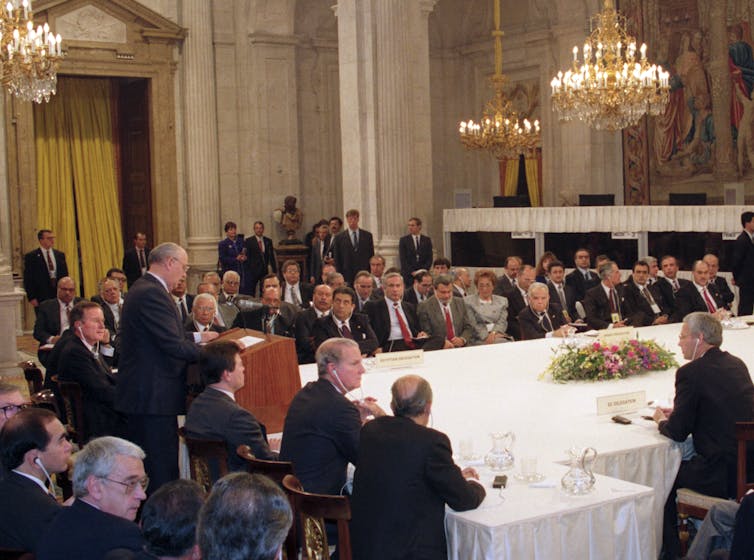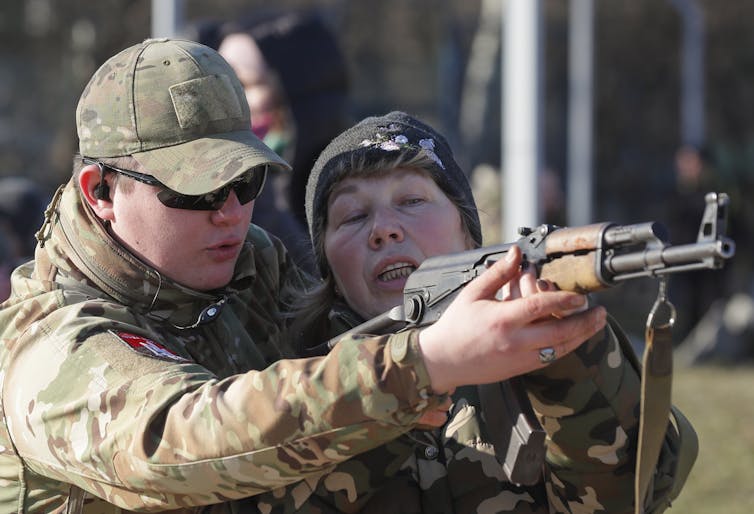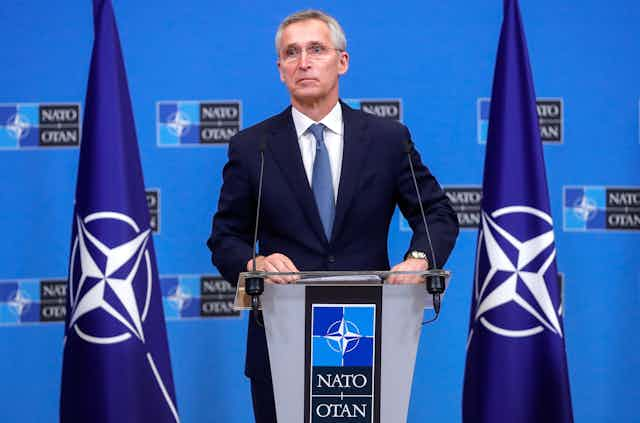The main issue highlighted by the crisis on the Ukraine borders over the past few months has predominantly focused on the role of Nato and the friction over the eastward expansion of the alliance. This has been a constant message emerging from the Kremlin: that the Nato membership of many parts of the old Soviet Bloc, and the prospective membership of Ukraine to the alliance, poses a threat to Russian sovereignty.
But the decision to accept former members of the Warsaw Pact, the defensive alliance which included the USSR and several eastern European countries, is being subject to a revisionist history. This is perpetuating a myth that Nato promised not to expand eastwards after the Soviet Union dissolved.
In 2014, the former Soviet leader Mikhail Gorbachev marked the 25th anniversary of the fall of the Berlin wall by noting in an interview that that Nato’s enlargement “was not discussed at all” at the time:
Not a single Eastern European country raised the issue, not even after the Warsaw Pact ceased to exist in 1991. Western leaders didn’t bring it up, either.
There was, he said, no promise not to enlarge the alliance, though in the same interview Gorbachev also stated that he thinks that enlargement was a “big mistake” and “a violation of the spirit of the statements and assurances made” in 1990.
Indeed, the only formal agreement signed between Nato countries and the USSR, before its breakup in December 1991, was the Treaty of Final Settlement with Respect to Germany. The promises made specifically relate to Germany, and the territory of the former GDR, which were on the deployment of non-German Nato forces into eastern Germany and the deployment of nuclear weapons – and these promises have been kept.

Looking for security
In seeking to develop a role in the international order after the end of the cold war, Nato realigned towards a crisis management and conflict prevention security function. The alliance agreed in July 1992 to offer to undertake peacekeeping duties on behalf of the United Nations and the Commission on Security and Cooperation in Europe. The North Atlantic Cooperation Council (NACC) had been established in 1991 with the USSR and former Warsaw Pact countries as members, to enable dialogue and enhance transparency between western and eastern Europe.
But many former Warsaw Pact countries wanted a greater level of assurance of their security after the collapse of the Soviet Union, especially Poland, Hungary and Czechoslovakia. These countries duly signed the Visegrad Declaration in February 1991, with the objective of “full involvement in the European … system of security”.
The relative security of the eastern European states was challenged during the 1990s due to the attempted October coup in Moscow in 1993, the first Chechen war in 1994 and Russian assistance to the breakaway Republic of Abkhazia in the south Caucasus. The combination of these events increased the perception of vulnerability, particularly in the Baltic states, indicating that Moscow was prepared to act militarily to pursue its security objectives.
Alongside the increasing security concerns of former Warsaw Pact countries, there was significant debate in the early 1990s about the merits of enlargement. Rather than jump straight into enlarging Nato, the Partnership For Peace (PfP) was established in 1994 and included NACC members as well as former Soviet Asian countries, such as Kyrgyzstan and Kazakhstan. The result was a greater formalisation of the security arrangements, initially developed by the NACC, into a structure that allowed for PfP members to engage in Nato peacekeeping operations in the former Yugoslavia.
Russia was a participant in these new security arrangements, and was keen to clarify that Nato enlargement was not a security threat to Russia. The then president of Russia, Boris Yeltsin, wrote in a September 1993 letter to the then US president, Bill Clinton: “Any possible integration of east European countries into Nato will not automatically lead to the alliance somehow turning against Russia.” So it was being clearly signalled that Russia did not object to the direction Europe’s new security architecture was following.
The three Visegrad countries were duly invited to join Nato at the 1997 Madrid Summit, joining in 1999. Slovakia was forced to wait until 2004. The move was widely supported by the people of the countries which joined. Hungarians voted 85.3% in favour of Nato membership in a referendum, for example.
Enemies no longer
The bedrock of the Nato-Russia relationship, the Nato-Russia Founding Act, was also signed at the 1997 Madrid Summit alongside the enlargement invitations. As the second formal agreement of the post-Cold War era between Russia and Nato, the act confirms that “Nato and Russia do not consider each other as adversaries”, and that Nato transformation is “a process that will continue”. It is, therefore, clear that Nato enlargement, was not considered a primary security concern for Russia.

The Baltic States openly pursued Nato membership, following the signing of the Baltic Charter of Partnership with the US in 1998. Rather than oppose Baltic membership, Russia actually helped it to happen by resolving border disputes with Lithuania.
Russia also demonstrated its continued to desire to remain in a cooperative security relationship by developing the Nato-Russia Council in 2002. Despite Russia’s occupation of the Crimea and Donbass, both legally still part of Ukraine, the council has still met a number of times a year, most recently on January 12 2022, alongside the informal lines of communications that continually remain open.
Nato enlargement has been a controversial subject – within as well as outside of the alliance – since the 1990s. But, when the present situation is placed within an appropriate context, it can be argued that Nato is not an aggressive, expansionist alliance. It also appears that Russia gave at least tacit approval to the enlargement, including the former Soviet Baltic states, and was signalling its desire to be a partner in the European security architecture.
Of course this has changed over the past decade. But the reason for that changed relationship is not Nato – it’s Vladimir Putin.

